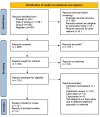Digital Impressions Versus Conventional Impressions in Prosthodontics: A Systematic Review
- PMID: 38304652
- PMCID: PMC10834103
- DOI: 10.7759/cureus.51537
Digital Impressions Versus Conventional Impressions in Prosthodontics: A Systematic Review
Abstract
The accuracy of definitive impressions has a significant impact on the quality of the final prosthesis. Elastic impression materials are commonly used in the traditional approach to replicate anatomical structures while indirectly fabricating prostheses. Digital impression has gained increasing popularity due to its various advantages, including three-dimensional previsualization, cost-effectiveness, and reduced time consumption. The objective of this study is to evaluate existing studies to provide an overview of the comparative advantages of digital impression techniques over conventional techniques. The review will focus on evaluating the accuracy, patient acceptability, operator preference, and time effectiveness of digital impression techniques in comparison to conventional techniques. The Population, Intervention, Comparison, and Outcome framework served as the basis for this study's search strategy. We conducted a comprehensive literature review by electronically searching articles published between 2000 and 2023 in PubMed, Medline, Cochrane, and the Web of Science. Furthermore, additional manual searches were conducted. The study examined the differences between optical impressions and traditional impressions in terms of accuracy, patient outcomes, and operator outcomes. It included both clinical and preclinical studies as well as randomized controlled trials. In conclusion, this review provides a short summary indicating that digital impressions exhibit comparable accuracy to conventional impressions without any statistically significant difference. This conclusion is based on an evaluation of accuracy, patient preference, and operator preference.
Keywords: dental implants; dental impression; dental impression technique; dentistry; digital dentistry; impression accuracy; prosthodontics.
Copyright © 2024, Ahmed et al.
Conflict of interest statement
The authors have declared that no competing interests exist.
Figures



References
-
- Taneva E, Kusnoto B, Evans CA. Issues in Contemporary Orthodontics. London: Intech Open; 2015. 3D scanning, imaging, and printing in orthodontics; pp. 862–867.
-
- In vivo precision of conventional and digital methods of obtaining complete-arch dental impressions. Ender A, Attin T, Mehl A. J Prosthet Dent. 2016;115:313–320. - PubMed
Publication types
LinkOut - more resources
Full Text Sources
